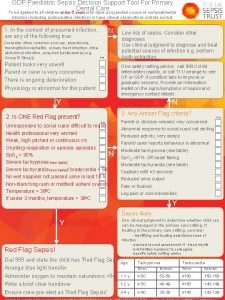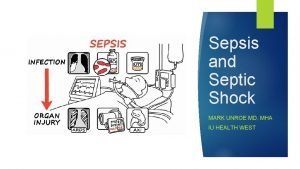GDP Paediatric Sepsis Decision Support Tool For Primary

- Slides: 1

GDP Paediatric Sepsis Decision Support Tool For Primary To be applied to all children aged 5 -11 Dental years who. Care have a suspected source of orofacial/dental infection (including postoperative infection) or have clinical observations outside normal limits 1. In the context of presumed infection, are any of the following true: N (consider other common sources: pneumonia, meningitis/encephalitis, urinary tract infection, intraabdominal infection, acquired bacteraemia (e. g. Tick Group B Strep)) Patient looks very unwell Parent or carer is very concerned Low risk of sepsis. Consider other diagnoses. Use clinical judgment to diagnose and treat potential sources of infection e. g. perform tooth extraction. Give safety netting advice: call 999 if child deteriorates rapidly, or call 111/ arrange to see GP or GDP if condition fails to improve or gradually worsens. Provide an information leaflet on the signs/symptoms of sepsis and emergency contact details. There is ongoing deterioration Physiology is abnormal for this patient Y N 2. Is ONE Red Flag present? 3. Any Amber Flag criteria? Tick Objective change in behaviour or mental state Parent or clinician remains very concerned Doesn’t wake if roused or won’t stay awake Behaving abnormally/ not wanting to play Looks very ill Significantly decreased activity/ parental concern Sp. O 2 < 90% on air Sp. O 2 < 92% on air Severe tachypnoea (see chart) Severe tachycardia (see chart) Bradycardia (< 60 per minute) Not passed urine in last 18 h Mottled, ashen or blue skin, lips or tongue Temperature < 360 C N Moderate tachypnoea (see chart) Moderate tachycardia (see chart) Cap refill time ≥ 3 seconds Reduced urine output Leg pain Cold feet or hands Y Sepsis likely Y Red Flag Sepsis! Use clinical judgment to determine whether the child can be managed in the primary care setting. If treating in the primary care setting, consider: -identifying and treating potential sources of infection -planned second assessment +/- blood results -brief written handover to colleagues -specific safety netting advice If immunity impaired refer for urgent hospital assessment Dial 999 and state the child has ‘Red Flag Sepsis’ Arrange blue light transfer Age Administer oxygen to maintain saturations >94%5 Tachypnoea Tachycardia Severe Moderate ≥ 29 27 -28 ≥ 130 120 -129 Write a brief clear handover 6 -7 y ≥ 27 24 -26 ≥ 120 110 -119 Ensure crew pre-alert as ‘Red Flag Sepsis’ 8 -11 y ≥ 25 22 -24 ≥ 115 105 -114

